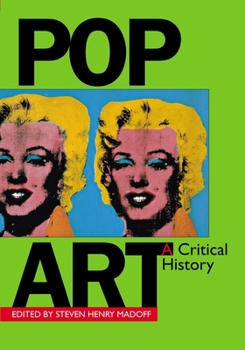Pop Art a Critical History
(Part of the Documents of Twentieth-Century Art Series)
Select Format
Select Condition 
Book Overview
Pop Art: A Critical History chronicles one of the most controversial art movements of the century. The anthology draws from a great range of sources, from the leading art magazines and art historical journals to newspapers and news magazines such as the New York Times, Life , and Newsweek . What emerges from this rich cross-section of critical and journalistic commentary is a fascinating view of the tumultuous rise of Pop art and its establishment as a major force in contemporary art. A broad selection of articles traces the emergence of the movement itself in England and America, as seen through the eyes of the working critics of the day. The focus then narrows to present in-depth writings on the four major Pop artists: Roy Lichtenstein, Claes Oldenburg, James Rosenquist, and Andy Warhol, along with an examination of many other artists involved in the movement. From reviews of the very first shows of many of these artists to interviews with them, to news stories about their collectors and their lifestyles, Pop Art: A Critical History represents the most complete and coherent record of Pop art yet published. The book concludes with an invaluable chronology of the major '60s exhibitions by Pop artists. Among the contributors are Lawrence Alloway, John Coplans, Donald Judd, Max Kozloff, Gerald Nordland, Peter Plagens, Barbara Rose, Robert Rosenblum, John Russell, Gene Swenson, and Sidney Tillim.
Format:Paperback
Language:English
ISBN:0520212436
ISBN13:9780520212435
Release Date:November 1997
Publisher:University of California Press
Length:450 Pages
Weight:2.10 lbs.
Dimensions:1.0" x 7.0" x 10.0"
Customer Reviews
2 ratings
The best anthology of its kind
Published by Thriftbooks.com User , 20 years ago
To put it briefly, I concur with the review from the Library Journal which the editor of the book quotes below. This is the best anthology of critical writing on Pop, and it largely supersedes previous ones such as Carol Mahsun's Pop Art: The Critical Dialogue. My only quibble is with the assertion in the editorial introduction that the work of Jim Dine and Tom Wesselmann is somehow "less incisive" (read "less impressive") than that of the "four-headed goliath named Lichtenstein-Oldenburg-Rosenquist-Warhol". It isn't, and neither is it less Pop than that of the goliath.
"Not-to-be-missed anthology.... Highly recommended."
Published by Thriftbooks.com User , 27 years ago
As the editor of this anthology, I wanted to pass on another review that the book has just received. My own quibble with the review from Kirkus is that I don't really understand why they would think that a 400-plus-page anthology of historical articles would be "a cozy read." The purpose of the book is to give a broad and deep view of what critics, journalists and art historians thought about Pop as it developed. It's not meant to be a page turner. It's meant to be a reference work full of useful and interesting pieces, some academic, some not. Here, in its entirety, is what "Library Journal" said: "This not-to-be-missed anthology collects stimulating articles, interviews, and other texts defining 'the phenomenon of Pop.' Madoff contributes a fine introductory overview, then presents 94 critical articles, both negative and positive, on this brash, vulgar, and successful style. Most are culled from contemporary American art magazines and newspapers--sometimes offering monthly entries--during the height of the Pop era of the 1960s. Students and specialists alike will find overlooked or forgotten material here and will especially note that many early discussions still ring true today. The book is divided into five sections: the precursors; reviews of work done from 1962 to 1970; the major artists (Lichtenstein, Oldenburg, Rosenquist, and Warhol); 11 artists on the periphery; and, finally, a few articles from the 1970s to 1990s. Discussions of single artists are most interesting, and Andy Warhol remains a standout. There is heavy reading but also journalistic stylings that will appeal to anyone interested in American culture of the Sixties. Highly recommended.--Mary Hamel-Schwulst, Towson State Univ., Md (LJ 10/1/97)"





